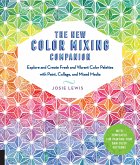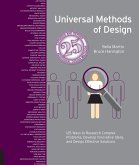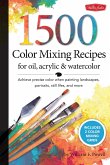Stephen Westland, Maggie Maggio
The Pocket Universal Principles of Color
100 Key Concepts for Understanding, Analyzing, and Working with Color
Stephen Westland, Maggie Maggio
The Pocket Universal Principles of Color
100 Key Concepts for Understanding, Analyzing, and Working with Color
- Broschiertes Buch
- Merkliste
- Auf die Merkliste
- Bewerten Bewerten
- Teilen
- Produkt teilen
- Produkterinnerung
- Produkterinnerung
The Pocket Universal Principles of Color is a concise visual presentation of 100 fundamental elements of color.
Andere Kunden interessierten sich auch für
![The Pocket Universal Methods of Design, Revised and Expanded The Pocket Universal Methods of Design, Revised and Expanded]() Bruce HaningtonThe Pocket Universal Methods of Design, Revised and Expanded19,99 €
Bruce HaningtonThe Pocket Universal Methods of Design, Revised and Expanded19,99 €![The Pocket Complete Color Harmony The Pocket Complete Color Harmony]() Tina SuttonThe Pocket Complete Color Harmony19,99 €
Tina SuttonThe Pocket Complete Color Harmony19,99 €![The New Color Mixing Companion The New Color Mixing Companion]() Josie LewisThe New Color Mixing Companion24,99 €
Josie LewisThe New Color Mixing Companion24,99 €![The Complete Color Harmony: Deluxe Edition The Complete Color Harmony: Deluxe Edition]() Tina SuttonThe Complete Color Harmony: Deluxe Edition22,99 €
Tina SuttonThe Complete Color Harmony: Deluxe Edition22,99 €![Universal Methods of Design, Expanded and Revised Universal Methods of Design, Expanded and Revised]() Bruce HaningtonUniversal Methods of Design, Expanded and Revised33,99 €
Bruce HaningtonUniversal Methods of Design, Expanded and Revised33,99 €![The Pocket Universal Principles of Design The Pocket Universal Principles of Design]() William LidwellThe Pocket Universal Principles of Design18,99 €
William LidwellThe Pocket Universal Principles of Design18,99 €![1,500 Color Mixing Recipes for Oil, Acrylic & Watercolor 1,500 Color Mixing Recipes for Oil, Acrylic & Watercolor]() William F Powell1,500 Color Mixing Recipes for Oil, Acrylic & Watercolor24,99 €
William F Powell1,500 Color Mixing Recipes for Oil, Acrylic & Watercolor24,99 €-
-
-
The Pocket Universal Principles of Color is a concise visual presentation of 100 fundamental elements of color.
Produktdetails
- Produktdetails
- Rockport Universal
- Verlag: Quarto Publishing Group USA Inc
- Seitenzahl: 216
- Erscheinungstermin: 10. Juni 2025
- Englisch
- Abmessung: 128mm x 132mm x 16mm
- Gewicht: 232g
- ISBN-13: 9780760393840
- ISBN-10: 0760393842
- Artikelnr.: 71911019
- Herstellerkennzeichnung
- Libri GmbH
- Europaallee 1
- 36244 Bad Hersfeld
- gpsr@libri.de
- Rockport Universal
- Verlag: Quarto Publishing Group USA Inc
- Seitenzahl: 216
- Erscheinungstermin: 10. Juni 2025
- Englisch
- Abmessung: 128mm x 132mm x 16mm
- Gewicht: 232g
- ISBN-13: 9780760393840
- ISBN-10: 0760393842
- Artikelnr.: 71911019
- Herstellerkennzeichnung
- Libri GmbH
- Europaallee 1
- 36244 Bad Hersfeld
- gpsr@libri.de
Stephen Westland is Professor of Color Science and Technology in the School of Design at the University of Leeds (UK). He was previously Head of the School of Design at Leeds (2006–2013). His research interests are color design, color vision, and color measurement and he has published over 250 peer-reviewed papers, book chapters, and books about these topics. He is a Fellow of the Society of Dyers and Colourists and was President of the Society in 2019. In 2008 he was awarded the Davies Medal from the Royal Photographic Society (London) for his color research. He has won numerous research grants from both government and industry and has recently worked with AkzoNobel, Colgate, and Unilever on color-related projects. He holds several visiting professorships, including at the University of Texas (USA) and Huazhong University of Science and Technology in Wuhan (China).Maggie Maggio is a designer, artist, and art educator who has studied, taught, and worked with color for over forty years. Her personal explorations into the science of light and pigments led to the creation of workshops for artists and designers who want to incorporate the latest research in color science into their creative practice. As a member of the Board of Directors of the US Inter-Society Color Council (ISCC) and co-chair of the International Color Association Study Group on Color Education, Maggie focuses on bridging between the art, science, and industry of color and advancing color literacy for the twenty-first century. She is the current chair of the Joint International Color Association/ISCC Color Literacy Project advocating for the integration of art and science in color education programs worldwide.
Introduction 8
01 #TheDress 10
02 Accessibility . 12
03 Additive Mixture . 14
04 Advancing and Receding 16
05 Albers’s Interaction of Color . . 18
06 Atmospheric Perspective . 20
07 Balance . 22
08 Basic Color Terms 24
09 Bauhaus . 26
10 Bezold Effect 28
11 Black and White 30
12 Blue Light . 32
13 Brand Colors 34
14 Camouflage . 36
15 Character Zones 38
16 Chemistry of Chromophores . 40
17 Chiaroscuro 42
18 Chroma . 44
19 Chromophobia 46
20 CIE System . 48
21 Cinematic Color . 50
22 CMYK 52
23 Color Constancy 54
24 Color Field Painting . 56
25 Color Forecasting 58
26 Color Literacy . 60
27 Color Management . 62
28 Color Meaning . 64
29 Color Measurement . 66
30 Color Order Systems . 68
31 Color Scales 70
32 Color Schemes . 72
33 Color Temperature 74
34 Colorants 76
35 Colorways 78
36 Complementary Colors 80
37 Context . 82
38 Contrast 84
39 Electromagnetic Spectrum 86
40 Emotion and Color 88
41 Environmental Color Design 90
42 Flat Color 92
43 Fluorescence . 94
44 Gamuts . 96
45 Geography of Color . 98
46 Goethe’s Theory of Colours . 100
47 Gradients . 102
48 Grisaille 104
49 Harmony 106
50 Hue Angle 108
51 Hue Circle . 110
52 Human Visual System . 112
53 Impressionism . 114
54 Infographic Color . 116
55 International Klein Blue 118
56 Itten’s The Art of Color 120
57 LED Color 122
58 Lighting . 124
59 Lightness 126
60 Limited Color Vision 128
61 Local Color . 130
62 Maxwell 132
63 Metamerism 134
64 Monochromatic 136
65 Munsell System . 138
66 Natural Color System 140
67 Nature’s Light 142
68 Near Neutrals 144
69 Newton’s Opticks 146
70 Op Art . 148
71 Palettes . 150
72 Pantone 152
73 Partitive Mixture . 154
74 Perception Triangle . 156
75 Permanence 158
76 Pointillism 160
77 Primary Colors . 162
78 Rayleigh Scattering . 164
79 RGB . 166
80 Safety Colors 168
81 Shadows . 170
82 Simultaneous Contrast . 172
83 Spectral Hues . 174
84 Structural Color . 176
85 Subtractive Mixture 178
86 Successive Contrast 180
87 Sustainable Color 182
88 Symbolic Color . . . . . . . . . . . . 184
89 Synesthesia 186
90 Technicolor 188
91 Texture . 190
92 Three Dimensions of Color 192
93 Tint, Shade, and Tone . 194
94 Traditional Color Theory 196
95 Transparency Effect 198
96 Trichromacy . 200
97 Undertone . 202
98 Unique Hues 204
99 Warm and Cool . 206
100 White Balance . 208
Acknowledgments 210
About the Authors . 212
Photo Credits 214
01 #TheDress 10
02 Accessibility . 12
03 Additive Mixture . 14
04 Advancing and Receding 16
05 Albers’s Interaction of Color . . 18
06 Atmospheric Perspective . 20
07 Balance . 22
08 Basic Color Terms 24
09 Bauhaus . 26
10 Bezold Effect 28
11 Black and White 30
12 Blue Light . 32
13 Brand Colors 34
14 Camouflage . 36
15 Character Zones 38
16 Chemistry of Chromophores . 40
17 Chiaroscuro 42
18 Chroma . 44
19 Chromophobia 46
20 CIE System . 48
21 Cinematic Color . 50
22 CMYK 52
23 Color Constancy 54
24 Color Field Painting . 56
25 Color Forecasting 58
26 Color Literacy . 60
27 Color Management . 62
28 Color Meaning . 64
29 Color Measurement . 66
30 Color Order Systems . 68
31 Color Scales 70
32 Color Schemes . 72
33 Color Temperature 74
34 Colorants 76
35 Colorways 78
36 Complementary Colors 80
37 Context . 82
38 Contrast 84
39 Electromagnetic Spectrum 86
40 Emotion and Color 88
41 Environmental Color Design 90
42 Flat Color 92
43 Fluorescence . 94
44 Gamuts . 96
45 Geography of Color . 98
46 Goethe’s Theory of Colours . 100
47 Gradients . 102
48 Grisaille 104
49 Harmony 106
50 Hue Angle 108
51 Hue Circle . 110
52 Human Visual System . 112
53 Impressionism . 114
54 Infographic Color . 116
55 International Klein Blue 118
56 Itten’s The Art of Color 120
57 LED Color 122
58 Lighting . 124
59 Lightness 126
60 Limited Color Vision 128
61 Local Color . 130
62 Maxwell 132
63 Metamerism 134
64 Monochromatic 136
65 Munsell System . 138
66 Natural Color System 140
67 Nature’s Light 142
68 Near Neutrals 144
69 Newton’s Opticks 146
70 Op Art . 148
71 Palettes . 150
72 Pantone 152
73 Partitive Mixture . 154
74 Perception Triangle . 156
75 Permanence 158
76 Pointillism 160
77 Primary Colors . 162
78 Rayleigh Scattering . 164
79 RGB . 166
80 Safety Colors 168
81 Shadows . 170
82 Simultaneous Contrast . 172
83 Spectral Hues . 174
84 Structural Color . 176
85 Subtractive Mixture 178
86 Successive Contrast 180
87 Sustainable Color 182
88 Symbolic Color . . . . . . . . . . . . 184
89 Synesthesia 186
90 Technicolor 188
91 Texture . 190
92 Three Dimensions of Color 192
93 Tint, Shade, and Tone . 194
94 Traditional Color Theory 196
95 Transparency Effect 198
96 Trichromacy . 200
97 Undertone . 202
98 Unique Hues 204
99 Warm and Cool . 206
100 White Balance . 208
Acknowledgments 210
About the Authors . 212
Photo Credits 214
Introduction 8
01 #TheDress 10
02 Accessibility . 12
03 Additive Mixture . 14
04 Advancing and Receding 16
05 Albers’s Interaction of Color . . 18
06 Atmospheric Perspective . 20
07 Balance . 22
08 Basic Color Terms 24
09 Bauhaus . 26
10 Bezold Effect 28
11 Black and White 30
12 Blue Light . 32
13 Brand Colors 34
14 Camouflage . 36
15 Character Zones 38
16 Chemistry of Chromophores . 40
17 Chiaroscuro 42
18 Chroma . 44
19 Chromophobia 46
20 CIE System . 48
21 Cinematic Color . 50
22 CMYK 52
23 Color Constancy 54
24 Color Field Painting . 56
25 Color Forecasting 58
26 Color Literacy . 60
27 Color Management . 62
28 Color Meaning . 64
29 Color Measurement . 66
30 Color Order Systems . 68
31 Color Scales 70
32 Color Schemes . 72
33 Color Temperature 74
34 Colorants 76
35 Colorways 78
36 Complementary Colors 80
37 Context . 82
38 Contrast 84
39 Electromagnetic Spectrum 86
40 Emotion and Color 88
41 Environmental Color Design 90
42 Flat Color 92
43 Fluorescence . 94
44 Gamuts . 96
45 Geography of Color . 98
46 Goethe’s Theory of Colours . 100
47 Gradients . 102
48 Grisaille 104
49 Harmony 106
50 Hue Angle 108
51 Hue Circle . 110
52 Human Visual System . 112
53 Impressionism . 114
54 Infographic Color . 116
55 International Klein Blue 118
56 Itten’s The Art of Color 120
57 LED Color 122
58 Lighting . 124
59 Lightness 126
60 Limited Color Vision 128
61 Local Color . 130
62 Maxwell 132
63 Metamerism 134
64 Monochromatic 136
65 Munsell System . 138
66 Natural Color System 140
67 Nature’s Light 142
68 Near Neutrals 144
69 Newton’s Opticks 146
70 Op Art . 148
71 Palettes . 150
72 Pantone 152
73 Partitive Mixture . 154
74 Perception Triangle . 156
75 Permanence 158
76 Pointillism 160
77 Primary Colors . 162
78 Rayleigh Scattering . 164
79 RGB . 166
80 Safety Colors 168
81 Shadows . 170
82 Simultaneous Contrast . 172
83 Spectral Hues . 174
84 Structural Color . 176
85 Subtractive Mixture 178
86 Successive Contrast 180
87 Sustainable Color 182
88 Symbolic Color . . . . . . . . . . . . 184
89 Synesthesia 186
90 Technicolor 188
91 Texture . 190
92 Three Dimensions of Color 192
93 Tint, Shade, and Tone . 194
94 Traditional Color Theory 196
95 Transparency Effect 198
96 Trichromacy . 200
97 Undertone . 202
98 Unique Hues 204
99 Warm and Cool . 206
100 White Balance . 208
Acknowledgments 210
About the Authors . 212
Photo Credits 214
01 #TheDress 10
02 Accessibility . 12
03 Additive Mixture . 14
04 Advancing and Receding 16
05 Albers’s Interaction of Color . . 18
06 Atmospheric Perspective . 20
07 Balance . 22
08 Basic Color Terms 24
09 Bauhaus . 26
10 Bezold Effect 28
11 Black and White 30
12 Blue Light . 32
13 Brand Colors 34
14 Camouflage . 36
15 Character Zones 38
16 Chemistry of Chromophores . 40
17 Chiaroscuro 42
18 Chroma . 44
19 Chromophobia 46
20 CIE System . 48
21 Cinematic Color . 50
22 CMYK 52
23 Color Constancy 54
24 Color Field Painting . 56
25 Color Forecasting 58
26 Color Literacy . 60
27 Color Management . 62
28 Color Meaning . 64
29 Color Measurement . 66
30 Color Order Systems . 68
31 Color Scales 70
32 Color Schemes . 72
33 Color Temperature 74
34 Colorants 76
35 Colorways 78
36 Complementary Colors 80
37 Context . 82
38 Contrast 84
39 Electromagnetic Spectrum 86
40 Emotion and Color 88
41 Environmental Color Design 90
42 Flat Color 92
43 Fluorescence . 94
44 Gamuts . 96
45 Geography of Color . 98
46 Goethe’s Theory of Colours . 100
47 Gradients . 102
48 Grisaille 104
49 Harmony 106
50 Hue Angle 108
51 Hue Circle . 110
52 Human Visual System . 112
53 Impressionism . 114
54 Infographic Color . 116
55 International Klein Blue 118
56 Itten’s The Art of Color 120
57 LED Color 122
58 Lighting . 124
59 Lightness 126
60 Limited Color Vision 128
61 Local Color . 130
62 Maxwell 132
63 Metamerism 134
64 Monochromatic 136
65 Munsell System . 138
66 Natural Color System 140
67 Nature’s Light 142
68 Near Neutrals 144
69 Newton’s Opticks 146
70 Op Art . 148
71 Palettes . 150
72 Pantone 152
73 Partitive Mixture . 154
74 Perception Triangle . 156
75 Permanence 158
76 Pointillism 160
77 Primary Colors . 162
78 Rayleigh Scattering . 164
79 RGB . 166
80 Safety Colors 168
81 Shadows . 170
82 Simultaneous Contrast . 172
83 Spectral Hues . 174
84 Structural Color . 176
85 Subtractive Mixture 178
86 Successive Contrast 180
87 Sustainable Color 182
88 Symbolic Color . . . . . . . . . . . . 184
89 Synesthesia 186
90 Technicolor 188
91 Texture . 190
92 Three Dimensions of Color 192
93 Tint, Shade, and Tone . 194
94 Traditional Color Theory 196
95 Transparency Effect 198
96 Trichromacy . 200
97 Undertone . 202
98 Unique Hues 204
99 Warm and Cool . 206
100 White Balance . 208
Acknowledgments 210
About the Authors . 212
Photo Credits 214








